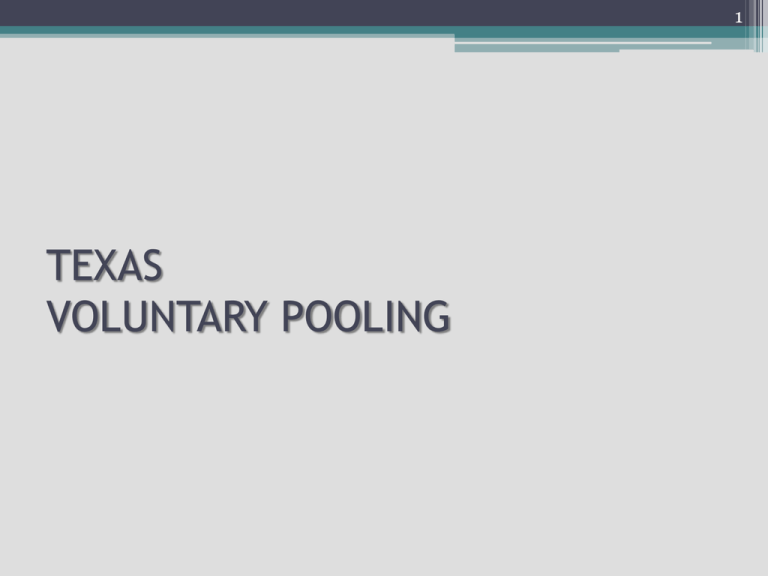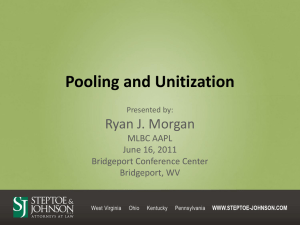SNELL-ARK-PP
advertisement

1 TEXAS VOLUNTARY POOLING 2 The Legacy of the Rule of Capture 3 1862 The Phillips and Woodford Wells Titusville, Pa 4 An Early (1860’s) “postcard” of Titusville area 5 1860’s Bank of Oil Creek 6 Huntington Beach, CA (1890’s?) 7 1903 Spindletop's Boiler Avenue 8 What is the Railroad Commission? • Established in 1891. • Constitutionally and Legislatively created to Regulate Rails. • Currently, Regulates the Oil and Gas Industry. • One of the largest and oldest agencies in the State of Texas. • Creates Rules, Enforces Rules, and Adjudicates Rules. 9 Your Most Important Resource http://www.rrc.state.tx.us/ 10 Increasing Jurisdiction • • • • • • • 1891 – Private Railroads 1919 – Oil and Gas 1920 – Gas Utilities 1931 – Buses and Trucks 1939 – LPG 1976 – Surface Mining 1991 – Alternative Fuels 11 Divisions of the Railroad Commission • • • • • Surface Mining Safety Gas Services General Counsel Oil and Gas 12 The Railroad Commission does not have jurisdiction over roads, traffic, noise, odors, leases, pipeline easements or royalty payments 13 “…it is well established that the commission does not have jurisdiction to decide disputes over title or rights of possession…Rather, the commission’s authority to grant permits is negative in nature – the commission, through a permit, merely removes a barrier the conservations laws would otherwise impose…” Rosenthal v. Railroad Commission of Texas, et al, 3rd Court of Appeals-Austin, Opinion ID 18426 14 WELL SPACING (Rule 37) • Lease Line Spacing • Between Well Spacing • 16 TAC § 3.37 WELL DENSITY (Rule 38) • Number of acres required to obtain a regular well permit • 16 TAC § 3.38 15 -Unit• UNIT – A commonly misused word in our business – especially in Texas. (Generally – 16 TAC § 3.38 (Rule 38) 16 Types of Units ▪ Drilling Unit ▪ Pooled Unit ▪ Proration Unit ▪ Standard Unit ▪ Producing Unit ▪ MIPA Unit ▪ Unitization 17 Drilling Unit The acreage assigned to a well for drilling purposes 16 TAC § 3.38(a)(2) Form W-1 18 Pooled Unit A combination of tracts allowed by a lease pooling clause in order to combine sufficient acreage to drill a well. 16 TAC § 3.40 Form P-12 19 Aspects of a Pooled Unit Cross-Conveyancing of interests Allocation of production – Usually on an acreage basis Tracts without a well “held” as if a well was drilled on the tract 20 Proration Unit The acreage assigned to a well for the purpose of assigning allowables and allocating allowable production to the well 16 TAC § 3.38(a)(3) Form P-15 21 Proration unit BUT – 16 TAC § 3.31(c)(1) If an allocation formula with acreage has not been adopted for a field, THERE ARE NO PRORATION UNITS. See: Davin McGinnis & H. Phillip Whitworth 22 Standard Units The well spacing and drilling unit acreage required to drill a well - Statewide Rules 16 TAC §3.38(b)(2)(a) 23 Production Units/Producing Units Not DEFINED Do Not Use 24 MIPA Unit – Forced Pooling TNRC Chapter 102 The Ammonite/GLO Problem 25 Unitization The combination of many tracts with producing wells for the purpose of secondary or tertiary recovery. TNRC Chapter 101 26 TYPES OF UNITS • • • • • • Voluntary Pooled Units Force Pooled Units Drilling Units Proration Units Fieldwide/Enhanced Recovery Units Specially Defined Units in the Lease Instruments 27 B E C F Each separately labeled tract = separate lease Tract F = 40 acre drilling unit Tracts C and F = 80 acre proration unit G J H K Tracts B, C, E , F, G, H, J , K = 320 acre voluntary pooled unit Tracts C, F, 80 acre portion of Tract D = 160 acre force pooled unit All Tracts (A-L) = fieldwide/enhanced recovery unit 28 VOLUNTARY POOLING • Why Pool? ▫ Avoid drilling unnecessary wells ▫ Protect each owner’s correlative rights to share in production ▫ Comply with RRC spacing and density regulations and obtain increased allowable ▫ Obtain the best geological location ▫ Maintain leases for future drilling 29 Authority to Pool • Pooling authority must be granted in the lease or by separate contract. • Texas courts are liberal in recognizing conveyance of pooling authority and in concluding such pooling clauses should not be construed in a narrow or limited manner. • Always start with the lease. 30 REMEMBER FUNDAMENTAL DISTINCTION • RRC rules (for spacing, density, allocation) do not create pooling authority. • But RRC rules can impact pooling authority ▫ “governmental authority” clauses – may pool to larger size if necessary for regular permit or full allowable 31 O&G Lease Pooling Provisions • Many different pooling provisions even in “standard” form leases • Events necessary to trigger pooling authority; e.g. ▫ for conservation ▫ avoid unnecessary drilling ▫ proper development • Don’t assume: read your lease pooling provision and all riders carefully! 32 Non-Contiguous Lands in Pooled Units • No requirement that pooled units consist of contiguous lands in the absence of express lease provisions to contrary • Special authority from the RRC is required to assign non-contiguous lands to a well for drilling permit or proration/allowable purposes • Window pane tracts 33 Effect of Changes From Gas to Oil Classification • If no provision in lease, classification change will trigger dissolution of a gas unit. • No second chance if lessee forms a gas unit but completes an oil well 34 Unpooled Undivided Interests Within Pooled Unit Boundaries • No equitable pooling in Texas • Cost-bearing interests ▫ Unpooled interests in a drillsite tract share as cotenants ▫ A cotenant may pool his undivided interest in a non-drillsite tract without the consent of the other cotenants ▫ Ratification of pooled units by non-drillsite costbearing interests 35 • Non-participating royalty interests (NPRI’s) ▫ “Heads,” I win; “Tails,” you lose. ▫ NPRI refuses to ratify lease if well located on NPRI’s lease that pooled with other lands/leases. ▫ NPRI ratifies pooled unit of well located outside of NPRI’s tract. 36 THE COMMON LAW A 36 37 THE COMMON LAW A B 37 38 THE COMMON LAW A B Pay royalty to A and B or B? 38 39 THE COMMON LAW Non-Apportionment A B 39 40 THE COMMON LAW The Non-Apportionment Rule Japhet v. McRae – Royalty is paid to the drillsite royalty owner only, unless there is: 1. pooling 2. a community lease 3. an entirety clause in the lease 4. a provision in the deed creating a separate tract that requires apportionment 41 THE COMMON LAW The Community Lease 1. Definition – One lease executed by the mineral owners of multiple tracts. The lessee is entitled to treat all tracts covered by the lease as a single “leased premises”. Parker v. Parker. 2. Negates the Non-Apportionment Rule by pooling all mineral owners as a matter of law. The non-apportionment result can be defeated by an express contract. 42 THE COMMON LAW The Consequence is a Cross-Conveyance? Veal v. Thomason dealt with determining who were necessary parties in pooling litigation. No Texas case has confirmed that actual title was cross-conveyed. Cross-conveyance is a theory, not a reality. 43 THE CONTRACT A Texas Court will interpret an unambiguous oil and gas lease provision strictly based upon the words actually used, not upon what the parties may have intended but did not express. Heritage Resources, Inc. v. NationsBank. Absent express authority, a lessee has no power to pool the lessor’s interest with the interest of others. Southeastern Pipeline Co. v. Tichacek. 44 THE CONTRACT B. A Lessee’s Pooling Authority is limited to the express terms contained in the oil and gas lease. Exxon Corp. v. Atlantic Richfield Co. A typical pooling clause addresses the following issues: 1. Authority to pool leased land with other lands for the reasons stated. 2. Identifies acreage limits for pooling for oil and for gas. 3. Allows “governmental regulation” to increase acres that can be pooled. 4. The act of pooling requires the lessee to record a written designation of unit in the county of the land leased. 5. Once the unit designation is recorded, operations and production from the drillsite are considered operations and production from the non-drillsite tracts. 6. Each royalty owner pooled is entitled to receive royalty based upon the fraction composed of the net mineral acres contained in his tract divided by the total mineral acres pooled. 45 THE CONTRACT C. The granting of pooling authority in the lease is interpreted broadly, Tiller v. Fields, but the exercise of that authority is often interpreted strictly, Jones v. Killingsworth. The best solution is a well-drafted pooling clause granting the lessee broad powers and wide discretion. See Texas Exxon Lease attached as Exhibit A. 46 THE CONTRACT D. Entirety Clause – Negates the nonapportionment rule. Royalty is paid on a lease basis, not a tract basis. Thomas Kilcrease Foundation v. Stanolind Oil & Gas Co. Most current lease forms do not contain an entirety clause. 47 THE CONTRACT E. Pugh Clause/Partial Lease Termination The rule of indivisibility requires that production from a lease, or from any land pooled with the leased land, maintains the lease in its entirety. Mathews v. Sun Oil Co. A “Pugh clause”, I prefer “lease termination clause”, allows a lease to partially terminate, vertically and/or horizontally, outside of producing acres and formations. Shown v. Getty Oil Company 48 THE CONTRACT F. Retained Acreage Clause. These clauses are sometimes referred to as retained acreage clauses, Pugh clauses, lease termination clauses, continuous development provisions, or release clauses. The result is that leases partially terminate vertically except for the acreage around a producing well, usually described as the acreage within a proration unit, or the number of acres required to obtain a maximum allowable. There are no proration units where there are no special field rules or where the allocation formula does not include acreage as a factor. Therefore, in those instances, a retained acreage clause that is based upon retention of the acres within a proration unit would be considered ambiguous. 49 THE CONTRACT F. Retained Acreage Clause. Do not confuse the acres a lessee can pool, which is determined by the authority granted in the pooling clause of the lease, with the acres the lessee can retain after the completion of the continuous drilling program, which is determined by the retained acreage clause. 50 THE CONTRACT H. Benefits of Successful Pooling 1. Each lessor relinquishes his right to have his tract developed and to receive all royalties from his tract. 2. Commencement of drilling and other operations on one tract benefit all tracts, and excuse the payment of delay rentals. 3. Production on any tract extends the primary term of all leases pooled. 4. Wells may be located within the pooled unit without respect to the individual property or lease lines and the lessee is relieved of its obligation to drill offset wells within the pooled acreage. 51 CATASTROPHES A. Timely recording perpetuates the nondrillsite tracts. In the usual event where the pooling clause does not provide the time when the pooling becomes effective, pooling is effective when the pooling instrument is recorded. Sauder v. Frey. If the pooling clause does not require that it be recorded, it is effective upon execution. Tiller v. Fields. I recommend that the pooling clause state that it is effective upon the date provided in the pooling instrument. 52 CATASTROPHES B. Designation of Unit must be executed by the person authorized. The only person expressly authorized is the lessee. If someone other than the lessee executes the pooling instruments, the pooling instrument should reflect that the third party is acting as the agent for a lessee. Pampell Interest, Inc. v. Woole. 53 CATASTROPHES C. Government Regulations may “prescribe” and/or “permit”. Field Rules sometimes provide that they “prescribe” (require) so many acres be attributed to a well, while the lessee is “permitted” (allowed) to attribute additional acreage to a well. Be aware that many pooling clauses allow the lessee to pool as “prescribed” by the RRC, but not as “permitted” by the RRC. Jones v. Killingsworth 54 CATASTROPHES D. Some “good faith/bad faith” issues. 1. Cannot include condemned land. Amoco Production Co. v. Underwood. 2. Cannot gerrymander. Circle Dot Ranch, Inc. v. Sidwell Oil & Gas, Inc., 3. Cannot ignore geology. Elliott v. Davis. 55 CATASTROPHES E. Duty of mineral owner/lessee to unleased mineral owner. 1. Drillsite tract – carry unleased mineral owner in drillsite until payout. Superior Oil Co. v. Roberts. 2. Non-drillsite tract – can be ignored after well completed. Fletcher v. Ricks Exploration. 3. No duty to offer unleased mineral owner right to participate in a pooled unit. Donnan v. Atlantic Richfield. 56 CATASTROPHES F. Duty to drillsite NRPO Cannot be pooled without owners consent. Brown v. Smith. Can ratify lease or pooling agreement, or not ratify anything, based upon its own self interest. MCZ, Inc. v. Triolo. 57 CATASTROPHES G. Duty to Non-Drillsite NPRO. Allowed to ratify at any time. May or may not receive proceeds from first production. DeBenavides v. Warren. NPRO nearly always wins. 58 CALCULATING ROYALTY WHERE NPRI IN DRILLSITE Lease – 3/16 R NPRI of 1/16 of O&G in drillsite No Ratification MO – 3/16 x ¼ (TF) = 3/64 NPRI – 1/16 x 8/8 = 4/64 R paid to MO = 0 Ratification MO – 3/16 of ¼ (TF) = 3/64 NPRI – 1/16 of ¼ (TF) = 1/64 R paid to MO 2/64 • 59 CALCULATING ROYALTY WHERE NPRI IN DRILLSITE Lease – 3/16 R NRPI of 1/16 of the R in drillsite No Ratification MO – 3/16 x ¼ (TF) = NPRI – 1/16 x 3/16 = R paid to MO – 3/64 (-) Ratification MO – 3/16 of ¼ (TF) = NPRI – 1/16 of 3/64 = R paid to MO – 15/16 of 3/64 = • 3/64 3/256 9/256 12/256 (3/64) 3/64 3/1024 45/1024 48/1024 (3/64) 59 60 Horizontal Drilling • Railroad Commission Rules Statewide Rules Or Special Field Rules 61 WELL SPACING (Rule 37) • Lease Line Spacing • Between Well Spacing WELL DENSITY (Rule 38) • Number of acres required to obtain a regular well permit 62 LEASE LINE SPACING • 467’ = Statewide Spacing Rule 467’’ 467’ • 330’ = Typical Shale Rule Barnett Shale Eagle Ford Haynesville 63 LEASE SPACING (PER RULE 86) Surface Hole Location 467’ 467’ T Terminus (Per Rule 86) 467’ 467’ PP Penetration Point 467’ Bottom Hole Location Horizontal Well 64 BETWEEN WELL SPACING Vertical 467’ 467’ BHL 467’ 467’ 1200’ = Statewide b/w Well Spacing 0’ in Spraberry 0’ in Most Shales 467 ’ 467’ Horizontal BHL 1200 ’ 65 -Warning• Rule 37(e) ▫ “No well drilled in violation of this section without special permit obtained, issued, or granted in the manner prescribed in said section, and no well drilled under such special permit or on the commission's own order which does not conform in all respects to the terms of such permit shall be permitted to produce either oil, gas, or geothermal resources and any such well so drilled in violation of said section or on the commission's own order shall be plugged. “ 66 Additional Acreage Assigned Spraberry 80+80+240 = 400 ac. Barnett Shale 320+32+240 = 592ac. Sugarkane (4200 x 0.2) + 320 = 1160 4200’ Lateral 67 Horizontal terms (rule 86(a)(1-6)) • • • • • • (1) Correlative interval--The depth interval designated by the field rules, by new field designation, or, where a correlative interval has not been designated by the commission, by other evidence submitted by the operator showing the producing interval for the field in which the horizontal drainhole is completed. (2) Horizontal drainhole--That portion of the wellbore drilled in the correlative interval, between the penetration point and the terminus. (3) Horizontal drainhole displacement--The calculated horizontal displacement of the horizontal drainhole from the penetration point to the terminus. (4) Horizontal drainhole well--Any well that is developed with one or more horizontal drainholes having a horizontal drainhole displacement of at least 100 feet. (5) Penetration point--The point where the drainhole penetrates the top of the correlative interval. (6) Terminus--The farthest point required to be surveyed along the horizontal drainhole from the penetration point and within the correlative interval. 68 MINERAL INTEREST POOLING ACT (MIPA) 69 OVERVIEW • Force Pooling Is Based On The Mineral Interest Pooling Act (“MIPA”) Enacted In 1965 But Effective March 8, 1961 • Purposes Of MIPA Is To Protect Correlative Rights, Prevent Waste Or Prevent Drilling Of Unnecessary Well • Texas Statute Is Unique Designed To Encourage Voluntary Pooling Before Going To Commission • Prerequisite For Force Pooling- Fair And Reasonable Voluntary Offer To Pool Which Has Not Been Accepted 70 MAY I FORCE POOL? PREREQUISITES TO FORCE POOLING Established Field No Wildcat Pooling Discovery Date of Field after 3/8/1961 Special Field Rules No State Lands Without Consent Two or More Tracts Common Reservoir or Consolidated Field Existing or Proposed Well 71 MAY I FORCE POOL? PREREQUISITES TO FORCE POOLING (CONTINUED) • Unit Size Limited 160 acres for oil well 650 acres + 10% tolerance for gas well Horizontal wells not contemplated • Achieve Statutory Purpose Avoid drilling of unnecessary wells Protect correlative rights Prevent waste • Voluntary Offer to Pool 72 PARTIES WHO MAY SEEK TO FORCE POOL • Authorized Force Pooling Applicants Existing Proration Unit-Any Owner including Royalty Owners Proposed Unit – Only Possessory Mineral Owners • School Land Board Has Standing to Force Pool Unleased Riverbeds and Channels GLO/Ammonite actively pursuing force pooling of unleased riverbeds into adjacent production 80+ applications filed – 200 more identified 73 VOLUNTARY POOLING OFFER Requirement Unique to Texas Law Jurisdictional Prerequisite for Force Pooling Elements –Carson v. RRC held that A fair and reasonable pooling offer takes into account relevant factors important to… A “reasonable person” in the position of the offeree RRC Liberally Construes What Constitutes a Fair and Reasonable Offer RRC legal staff recently followed stricter interpretation 74 Unfair Offers All or none in a proposed 8 well development For dual completion, no apportionment of costs and interest between zones Attaching form JOA without blanks filled in to offer Pooling drillsite royalty on same yardstick basis as others in pooled unit after well drilled Carson v. RRC rejected MIPA standard for existing proration units Pooling for a reservoir from which existing well is not currently producing 75 Fair Offers Risk Penalty Not Required Drainage of Specific Acreage in Unit Not RequiredOnly Equivalent Timing- Not an Issue If Made Before Hearing Statutory-Participation on Same Yardstick Basis as Others in an Existing Unit –Except for Carson facts Pool, Lease or Farmout for Residential Lots Whether Offer to Lease Is Offer to Pool 76 ACREAGE SUBJECT TO FORCE POOLING MIPA Limits Pooling to Acreage that Is Productive at the Time of Final Order But Determination of Productive Acreage Based on the Evidence at the Hearing- Not Updated Applies Even for Water Drive Reservoirs with Changing Productive Limits 77 Finley Resources Case Expands Traditional Application of MIPA • Background Facts Finley leased and pooled 90.616 acres (300 + lots) in urban subdivision of Ft. Worth. Horizontal well needed to produce Barnett Shale hydrocarbons. Trespass issues caused by 5.704 acres (26 lots) of unfindable or non-responsive unleased owners prevent drilling of well. 78 Figure 3 • • Finley made voluntary offer to unleased owners – lease, pool or farmout for 96.32 acre MIPA unit. No party appeared at hearing to protest. 79 Finley Resources Case Expands Traditional Application of MIPA (continued) • Opposing Positions Finley: MIPA Unit necessary to drill well to prevent waste, protect correlative rights of working interests and 100’s of royalty owners and to prevent drilling unnecessary wells. Examiners: MIPA limited to protect small tracts, not to give large tract lessees more flexibility in development. • RRC Granted MIPA Application Action 1+ years after Finley filed application. Granted force pooled parties 1/5 royalty and carried 4/5 working interest. 80 Finley Resources Case Expands Traditional Application of MIPA (continued) Significance of Finley Decision Remedy for operators to drill wells over objection of unleased/unfindable parties refusing to lease or pool. Threat of force pooling encourages good faith negotiations – MIPA cases are burdensome for all parties. 81 CONCLUSIONS • MIPA May Have Been Historically Effective To Promote Its Overriding Purpose To Encourage Voluntary Pooling. • This Result Not Applicable For Unfindable/ Unidentifiable or Unresponsive Owners. • Finley Decision Is An Antidote For This Problem. • Threat of MIPA Action For Proposed Wells Should Encourage Non-responsive Owners To Negotiate. • MIPA May be Used to Assist In Drilling Wells Previously Undrillable. 82 In An Election Year, Support the oil and gas Industry Learn Listen Lampoon/Harpoon 83 THANK YOU QUESTIONS? George Snell Steptoe & Johnson PLLC george.snell@steptoe-johnson.com








